Quality Planning and Analysis: House Construction Project, University
VerifiedAdded on 2020/05/08
|38
|8828
|64
Project
AI Summary
This project focuses on quality planning and analysis within the context of constructing a house in Perth, Australia, undertaken by PHC projects in collaboration with Ventura Homes. The project comprehensively addresses various aspects of quality management, beginning with an introduction outlining key functions such as design, scheduling, and document management. The assignment delves into customer satisfaction, incorporating stakeholder analysis and methods for capturing customer needs, including Kano analysis to categorize customer requirements into must-haves, performance needs, and delighters. Design requirements are established through Quality Function Deployment (QFD) and Design Risk Analysis (FMEA). The project also explores supplier selection and evaluation, identifying components and developing selection criteria. Statistical Process Control (SPC) is applied to analyze processes, employing SPC charts and relevant tools. Finally, problem-solving techniques are discussed, including the identification and use of problem-solving tools to address potential issues during construction. This project provides a detailed overview of how to ensure quality and customer satisfaction in a construction project.
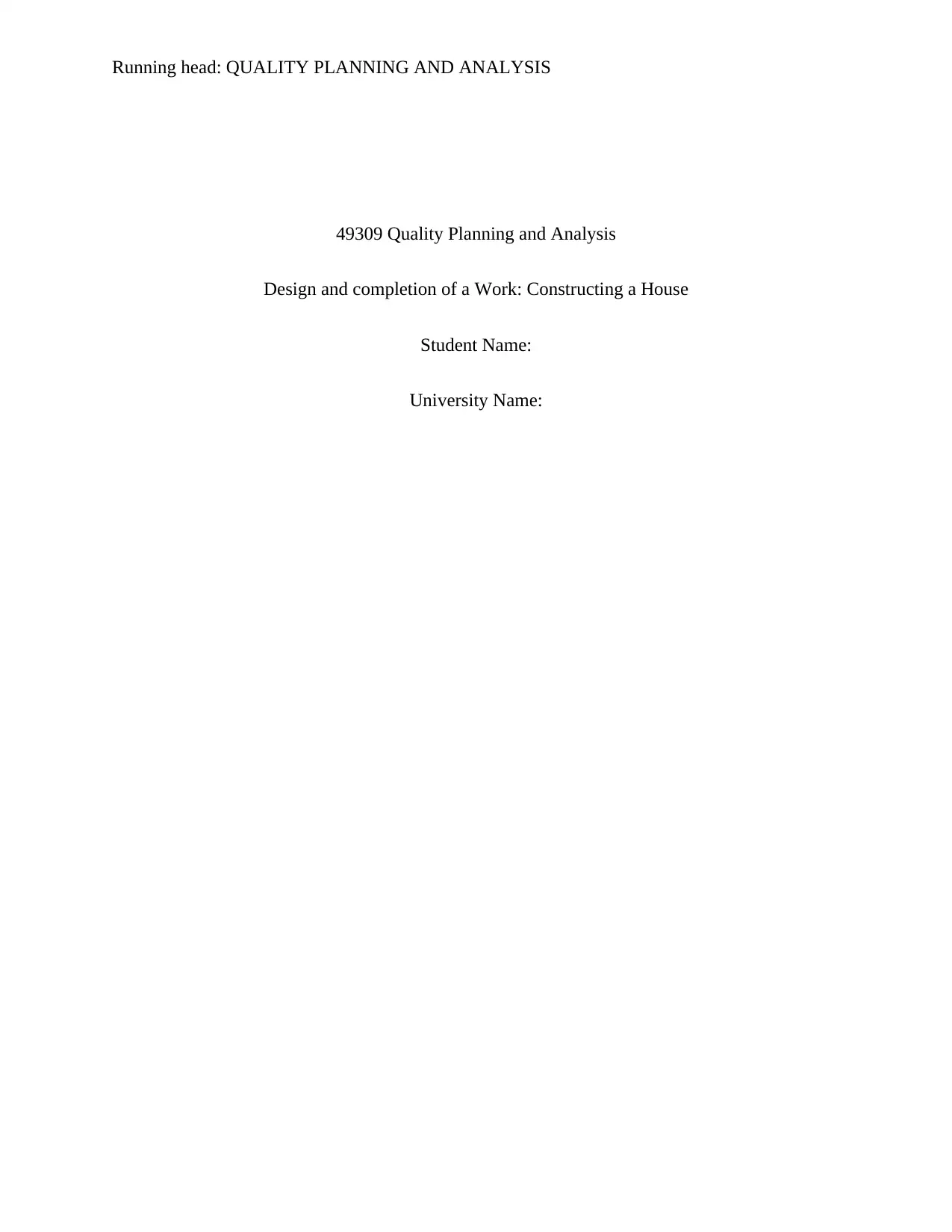
Running head: QUALITY PLANNING AND ANALYSIS
49309 Quality Planning and Analysis
Design and completion of a Work: Constructing a House
Student Name:
University Name:
49309 Quality Planning and Analysis
Design and completion of a Work: Constructing a House
Student Name:
University Name:
Paraphrase This Document
Need a fresh take? Get an instant paraphrase of this document with our AI Paraphraser
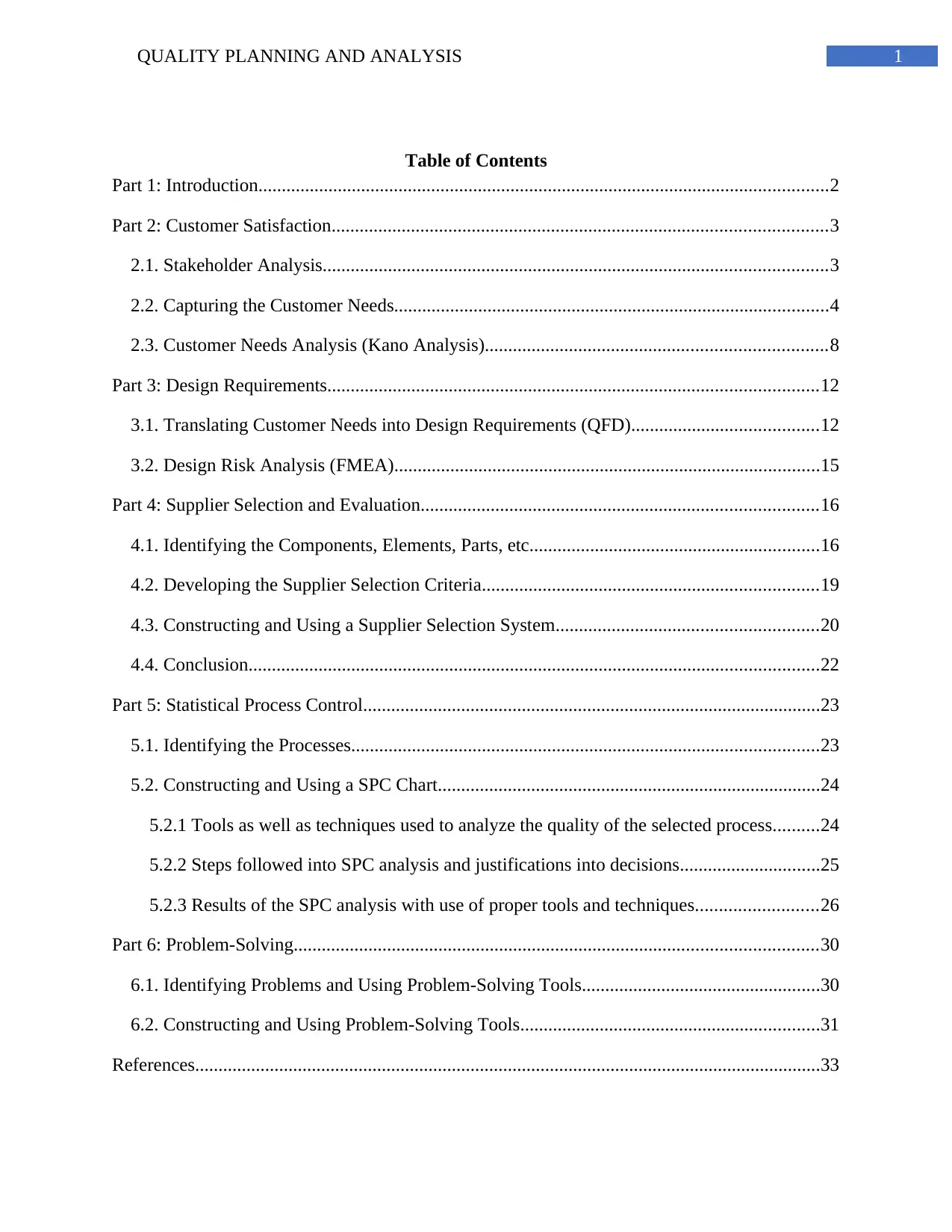
1QUALITY PLANNING AND ANALYSIS
Table of Contents
Part 1: Introduction..........................................................................................................................2
Part 2: Customer Satisfaction..........................................................................................................3
2.1. Stakeholder Analysis............................................................................................................3
2.2. Capturing the Customer Needs.............................................................................................4
2.3. Customer Needs Analysis (Kano Analysis).........................................................................8
Part 3: Design Requirements.........................................................................................................12
3.1. Translating Customer Needs into Design Requirements (QFD)........................................12
3.2. Design Risk Analysis (FMEA)...........................................................................................15
Part 4: Supplier Selection and Evaluation.....................................................................................16
4.1. Identifying the Components, Elements, Parts, etc..............................................................16
4.2. Developing the Supplier Selection Criteria........................................................................19
4.3. Constructing and Using a Supplier Selection System........................................................20
4.4. Conclusion..........................................................................................................................22
Part 5: Statistical Process Control..................................................................................................23
5.1. Identifying the Processes....................................................................................................23
5.2. Constructing and Using a SPC Chart..................................................................................24
5.2.1 Tools as well as techniques used to analyze the quality of the selected process..........24
5.2.2 Steps followed into SPC analysis and justifications into decisions..............................25
5.2.3 Results of the SPC analysis with use of proper tools and techniques..........................26
Part 6: Problem-Solving................................................................................................................30
6.1. Identifying Problems and Using Problem-Solving Tools...................................................30
6.2. Constructing and Using Problem-Solving Tools................................................................31
References......................................................................................................................................33
Table of Contents
Part 1: Introduction..........................................................................................................................2
Part 2: Customer Satisfaction..........................................................................................................3
2.1. Stakeholder Analysis............................................................................................................3
2.2. Capturing the Customer Needs.............................................................................................4
2.3. Customer Needs Analysis (Kano Analysis).........................................................................8
Part 3: Design Requirements.........................................................................................................12
3.1. Translating Customer Needs into Design Requirements (QFD)........................................12
3.2. Design Risk Analysis (FMEA)...........................................................................................15
Part 4: Supplier Selection and Evaluation.....................................................................................16
4.1. Identifying the Components, Elements, Parts, etc..............................................................16
4.2. Developing the Supplier Selection Criteria........................................................................19
4.3. Constructing and Using a Supplier Selection System........................................................20
4.4. Conclusion..........................................................................................................................22
Part 5: Statistical Process Control..................................................................................................23
5.1. Identifying the Processes....................................................................................................23
5.2. Constructing and Using a SPC Chart..................................................................................24
5.2.1 Tools as well as techniques used to analyze the quality of the selected process..........24
5.2.2 Steps followed into SPC analysis and justifications into decisions..............................25
5.2.3 Results of the SPC analysis with use of proper tools and techniques..........................26
Part 6: Problem-Solving................................................................................................................30
6.1. Identifying Problems and Using Problem-Solving Tools...................................................30
6.2. Constructing and Using Problem-Solving Tools................................................................31
References......................................................................................................................................33
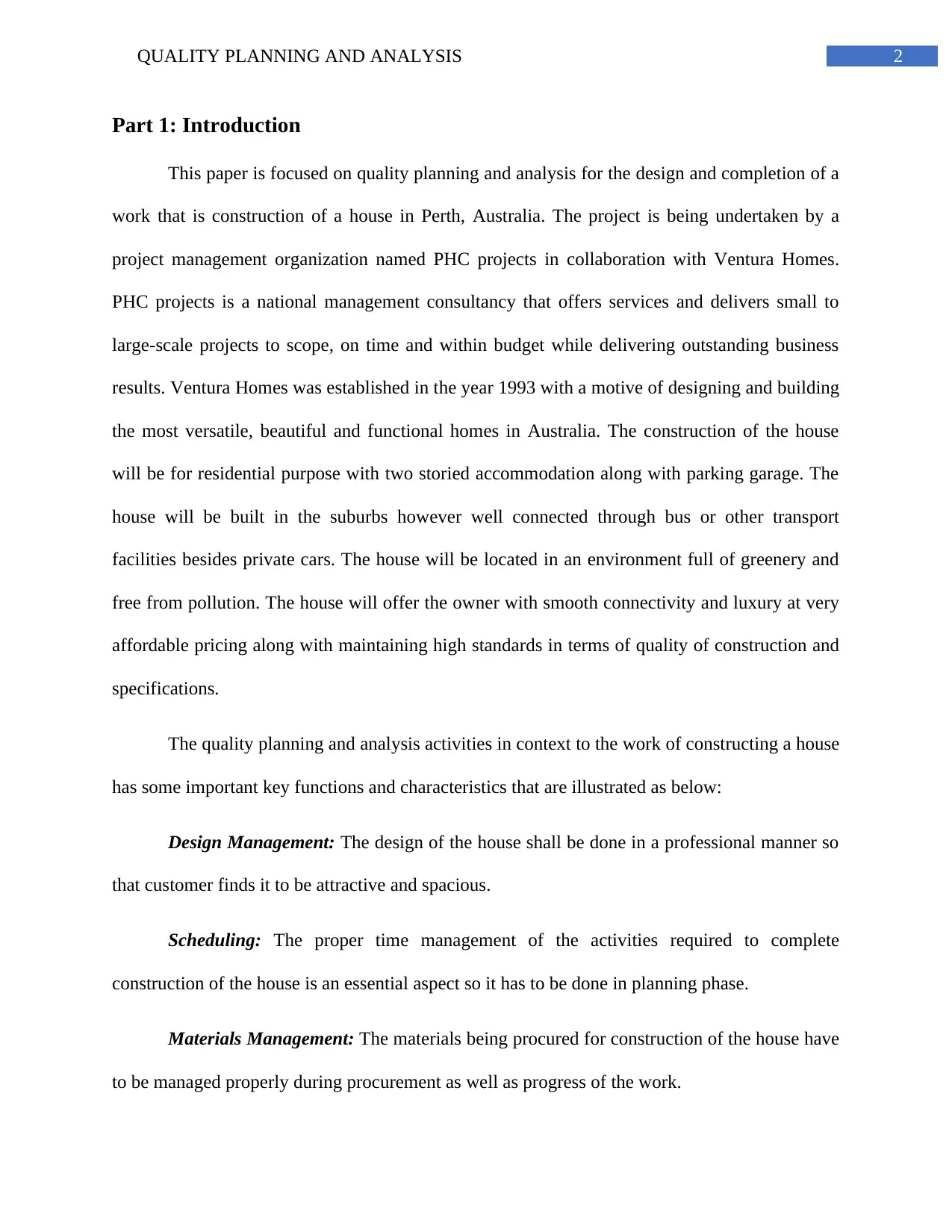
2QUALITY PLANNING AND ANALYSIS
Part 1: Introduction
This paper is focused on quality planning and analysis for the design and completion of a
work that is construction of a house in Perth, Australia. The project is being undertaken by a
project management organization named PHC projects in collaboration with Ventura Homes.
PHC projects is a national management consultancy that offers services and delivers small to
large-scale projects to scope, on time and within budget while delivering outstanding business
results. Ventura Homes was established in the year 1993 with a motive of designing and building
the most versatile, beautiful and functional homes in Australia. The construction of the house
will be for residential purpose with two storied accommodation along with parking garage. The
house will be built in the suburbs however well connected through bus or other transport
facilities besides private cars. The house will be located in an environment full of greenery and
free from pollution. The house will offer the owner with smooth connectivity and luxury at very
affordable pricing along with maintaining high standards in terms of quality of construction and
specifications.
The quality planning and analysis activities in context to the work of constructing a house
has some important key functions and characteristics that are illustrated as below:
Design Management: The design of the house shall be done in a professional manner so
that customer finds it to be attractive and spacious.
Scheduling: The proper time management of the activities required to complete
construction of the house is an essential aspect so it has to be done in planning phase.
Materials Management: The materials being procured for construction of the house have
to be managed properly during procurement as well as progress of the work.
Part 1: Introduction
This paper is focused on quality planning and analysis for the design and completion of a
work that is construction of a house in Perth, Australia. The project is being undertaken by a
project management organization named PHC projects in collaboration with Ventura Homes.
PHC projects is a national management consultancy that offers services and delivers small to
large-scale projects to scope, on time and within budget while delivering outstanding business
results. Ventura Homes was established in the year 1993 with a motive of designing and building
the most versatile, beautiful and functional homes in Australia. The construction of the house
will be for residential purpose with two storied accommodation along with parking garage. The
house will be built in the suburbs however well connected through bus or other transport
facilities besides private cars. The house will be located in an environment full of greenery and
free from pollution. The house will offer the owner with smooth connectivity and luxury at very
affordable pricing along with maintaining high standards in terms of quality of construction and
specifications.
The quality planning and analysis activities in context to the work of constructing a house
has some important key functions and characteristics that are illustrated as below:
Design Management: The design of the house shall be done in a professional manner so
that customer finds it to be attractive and spacious.
Scheduling: The proper time management of the activities required to complete
construction of the house is an essential aspect so it has to be done in planning phase.
Materials Management: The materials being procured for construction of the house have
to be managed properly during procurement as well as progress of the work.
⊘ This is a preview!⊘
Do you want full access?
Subscribe today to unlock all pages.

Trusted by 1+ million students worldwide
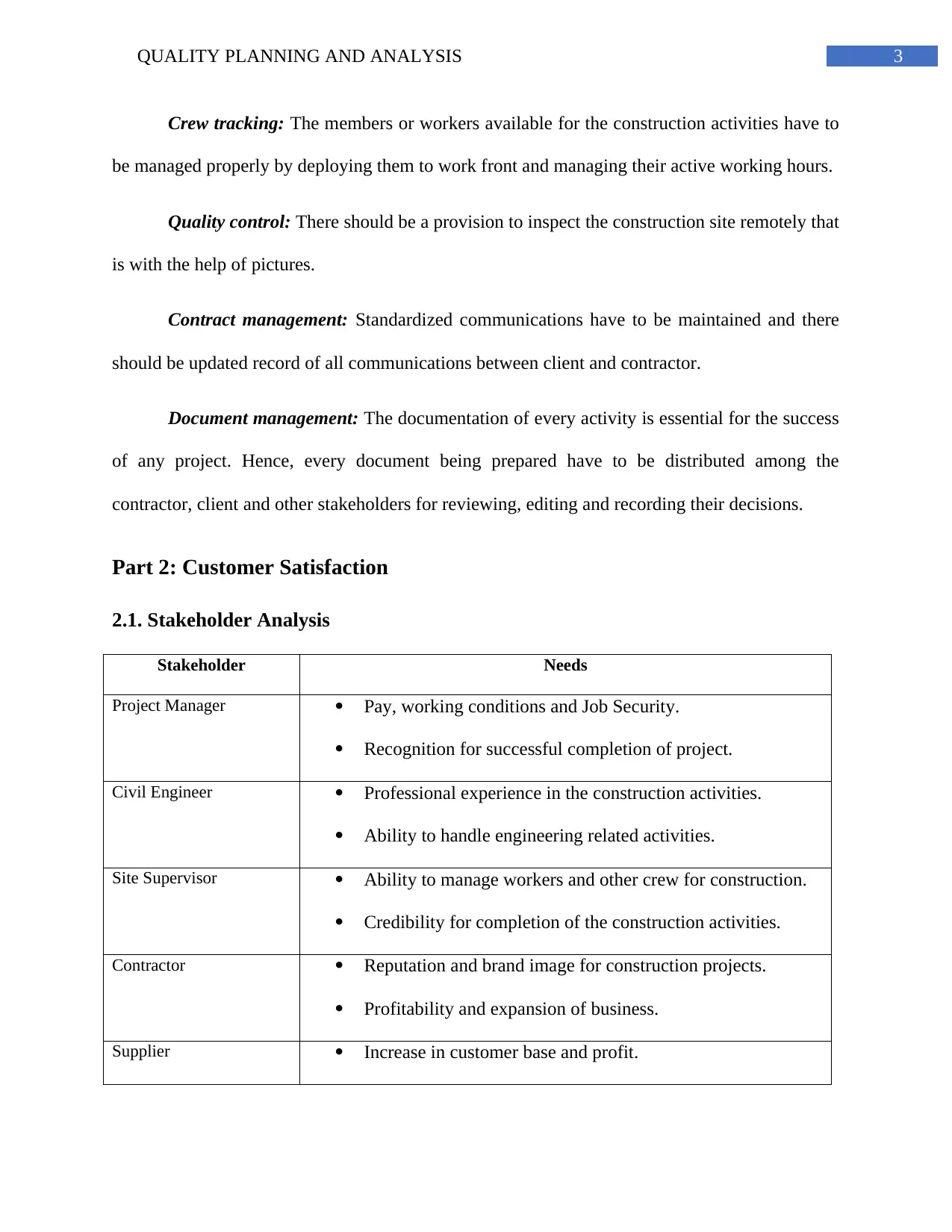
3QUALITY PLANNING AND ANALYSIS
Crew tracking: The members or workers available for the construction activities have to
be managed properly by deploying them to work front and managing their active working hours.
Quality control: There should be a provision to inspect the construction site remotely that
is with the help of pictures.
Contract management: Standardized communications have to be maintained and there
should be updated record of all communications between client and contractor.
Document management: The documentation of every activity is essential for the success
of any project. Hence, every document being prepared have to be distributed among the
contractor, client and other stakeholders for reviewing, editing and recording their decisions.
Part 2: Customer Satisfaction
2.1. Stakeholder Analysis
Stakeholder Needs
Project Manager Pay, working conditions and Job Security.
Recognition for successful completion of project.
Civil Engineer Professional experience in the construction activities.
Ability to handle engineering related activities.
Site Supervisor Ability to manage workers and other crew for construction.
Credibility for completion of the construction activities.
Contractor Reputation and brand image for construction projects.
Profitability and expansion of business.
Supplier Increase in customer base and profit.
Crew tracking: The members or workers available for the construction activities have to
be managed properly by deploying them to work front and managing their active working hours.
Quality control: There should be a provision to inspect the construction site remotely that
is with the help of pictures.
Contract management: Standardized communications have to be maintained and there
should be updated record of all communications between client and contractor.
Document management: The documentation of every activity is essential for the success
of any project. Hence, every document being prepared have to be distributed among the
contractor, client and other stakeholders for reviewing, editing and recording their decisions.
Part 2: Customer Satisfaction
2.1. Stakeholder Analysis
Stakeholder Needs
Project Manager Pay, working conditions and Job Security.
Recognition for successful completion of project.
Civil Engineer Professional experience in the construction activities.
Ability to handle engineering related activities.
Site Supervisor Ability to manage workers and other crew for construction.
Credibility for completion of the construction activities.
Contractor Reputation and brand image for construction projects.
Profitability and expansion of business.
Supplier Increase in customer base and profit.
Paraphrase This Document
Need a fresh take? Get an instant paraphrase of this document with our AI Paraphraser
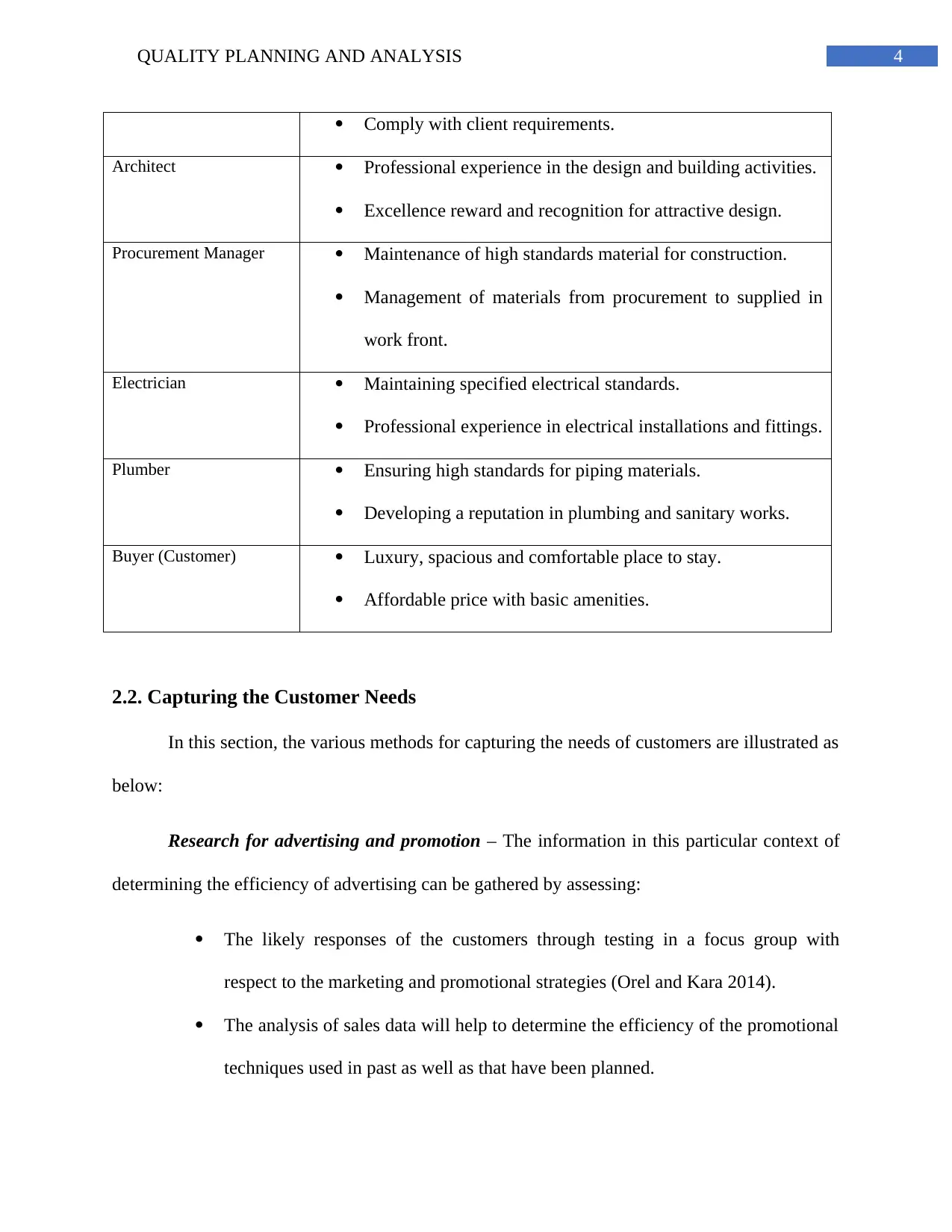
4QUALITY PLANNING AND ANALYSIS
Comply with client requirements.
Architect Professional experience in the design and building activities.
Excellence reward and recognition for attractive design.
Procurement Manager Maintenance of high standards material for construction.
Management of materials from procurement to supplied in
work front.
Electrician Maintaining specified electrical standards.
Professional experience in electrical installations and fittings.
Plumber Ensuring high standards for piping materials.
Developing a reputation in plumbing and sanitary works.
Buyer (Customer) Luxury, spacious and comfortable place to stay.
Affordable price with basic amenities.
2.2. Capturing the Customer Needs
In this section, the various methods for capturing the needs of customers are illustrated as
below:
Research for advertising and promotion – The information in this particular context of
determining the efficiency of advertising can be gathered by assessing:
The likely responses of the customers through testing in a focus group with
respect to the marketing and promotional strategies (Orel and Kara 2014).
The analysis of sales data will help to determine the efficiency of the promotional
techniques used in past as well as that have been planned.
Comply with client requirements.
Architect Professional experience in the design and building activities.
Excellence reward and recognition for attractive design.
Procurement Manager Maintenance of high standards material for construction.
Management of materials from procurement to supplied in
work front.
Electrician Maintaining specified electrical standards.
Professional experience in electrical installations and fittings.
Plumber Ensuring high standards for piping materials.
Developing a reputation in plumbing and sanitary works.
Buyer (Customer) Luxury, spacious and comfortable place to stay.
Affordable price with basic amenities.
2.2. Capturing the Customer Needs
In this section, the various methods for capturing the needs of customers are illustrated as
below:
Research for advertising and promotion – The information in this particular context of
determining the efficiency of advertising can be gathered by assessing:
The likely responses of the customers through testing in a focus group with
respect to the marketing and promotional strategies (Orel and Kara 2014).
The analysis of sales data will help to determine the efficiency of the promotional
techniques used in past as well as that have been planned.
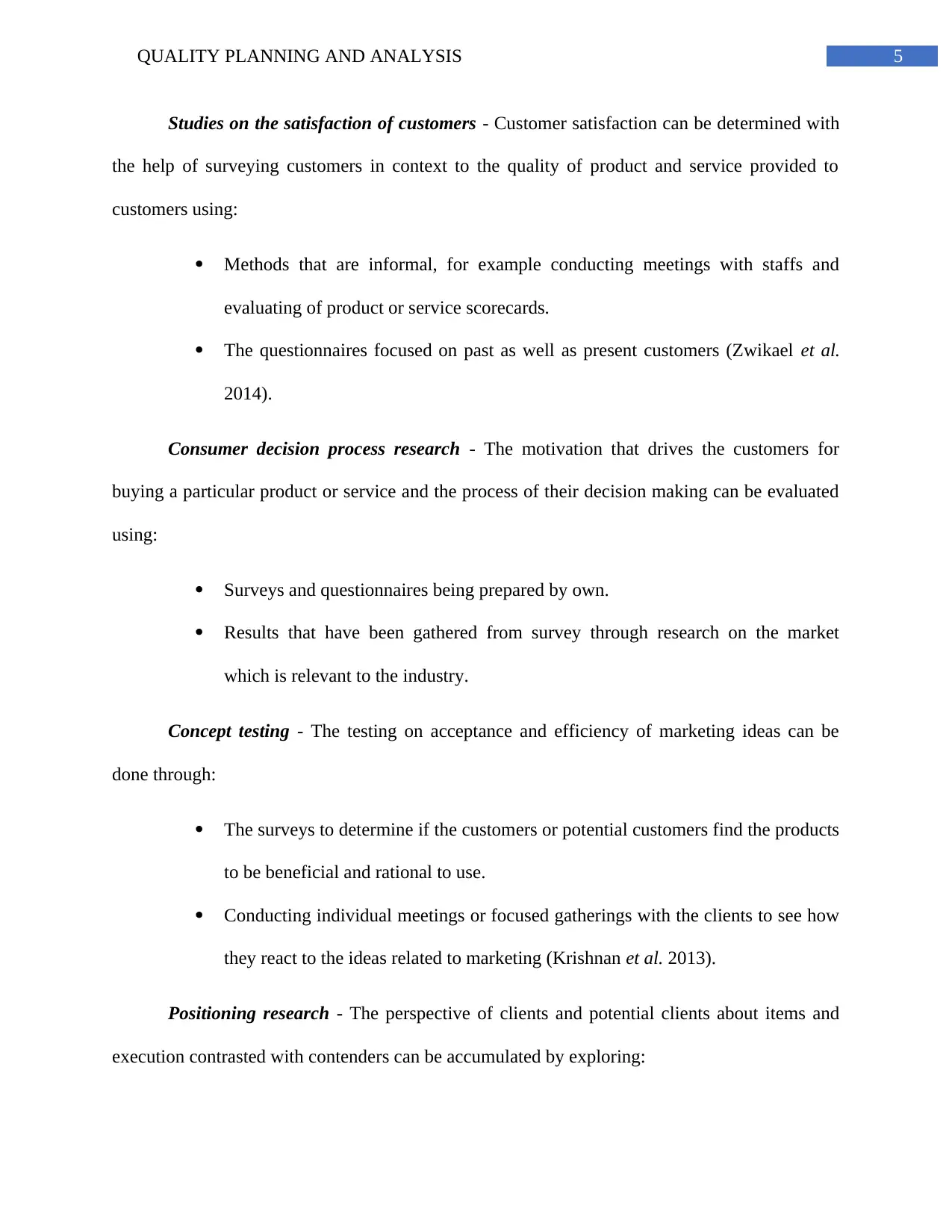
5QUALITY PLANNING AND ANALYSIS
Studies on the satisfaction of customers - Customer satisfaction can be determined with
the help of surveying customers in context to the quality of product and service provided to
customers using:
Methods that are informal, for example conducting meetings with staffs and
evaluating of product or service scorecards.
The questionnaires focused on past as well as present customers (Zwikael et al.
2014).
Consumer decision process research - The motivation that drives the customers for
buying a particular product or service and the process of their decision making can be evaluated
using:
Surveys and questionnaires being prepared by own.
Results that have been gathered from survey through research on the market
which is relevant to the industry.
Concept testing - The testing on acceptance and efficiency of marketing ideas can be
done through:
The surveys to determine if the customers or potential customers find the products
to be beneficial and rational to use.
Conducting individual meetings or focused gatherings with the clients to see how
they react to the ideas related to marketing (Krishnan et al. 2013).
Positioning research - The perspective of clients and potential clients about items and
execution contrasted with contenders can be accumulated by exploring:
Studies on the satisfaction of customers - Customer satisfaction can be determined with
the help of surveying customers in context to the quality of product and service provided to
customers using:
Methods that are informal, for example conducting meetings with staffs and
evaluating of product or service scorecards.
The questionnaires focused on past as well as present customers (Zwikael et al.
2014).
Consumer decision process research - The motivation that drives the customers for
buying a particular product or service and the process of their decision making can be evaluated
using:
Surveys and questionnaires being prepared by own.
Results that have been gathered from survey through research on the market
which is relevant to the industry.
Concept testing - The testing on acceptance and efficiency of marketing ideas can be
done through:
The surveys to determine if the customers or potential customers find the products
to be beneficial and rational to use.
Conducting individual meetings or focused gatherings with the clients to see how
they react to the ideas related to marketing (Krishnan et al. 2013).
Positioning research - The perspective of clients and potential clients about items and
execution contrasted with contenders can be accumulated by exploring:
⊘ This is a preview!⊘
Do you want full access?
Subscribe today to unlock all pages.

Trusted by 1+ million students worldwide
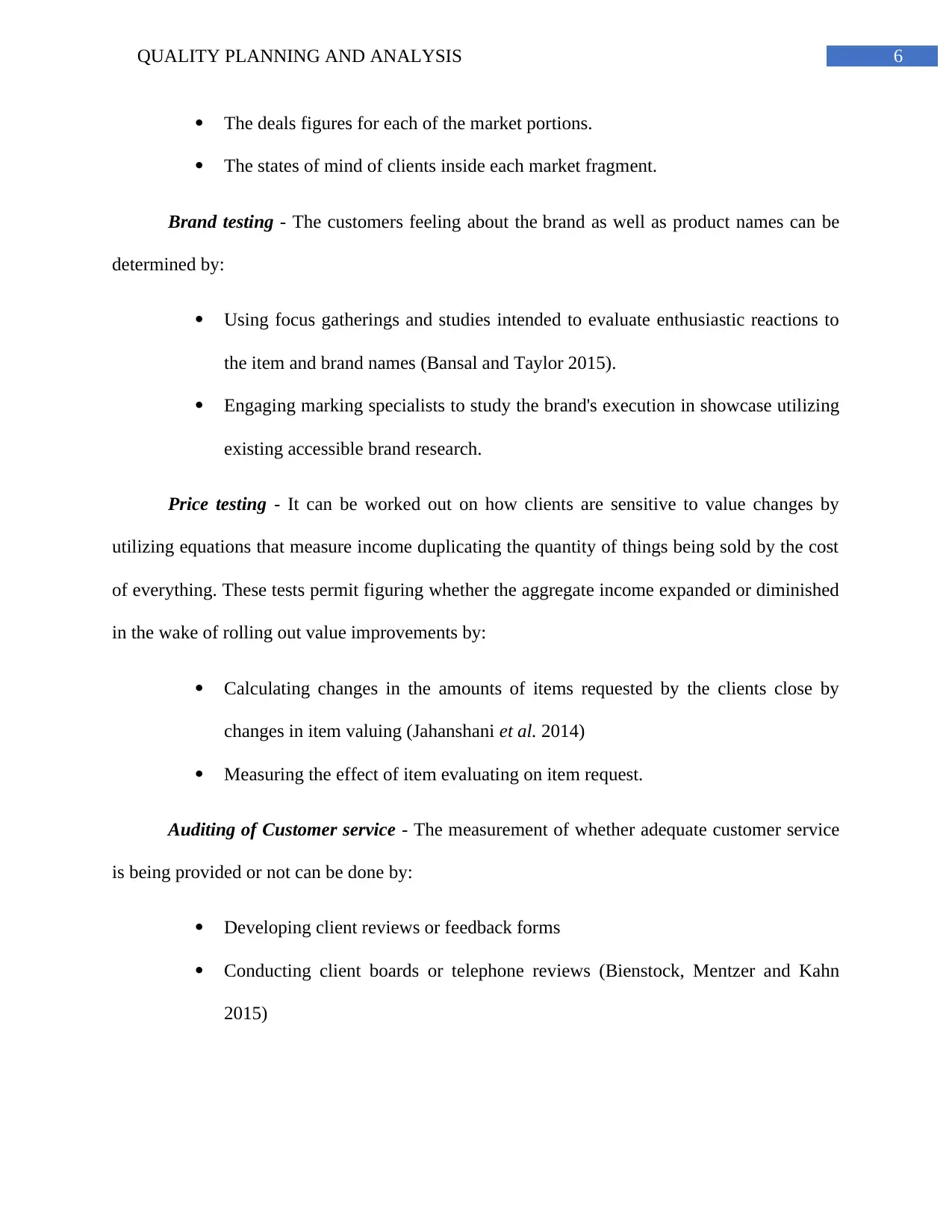
6QUALITY PLANNING AND ANALYSIS
The deals figures for each of the market portions.
The states of mind of clients inside each market fragment.
Brand testing - The customers feeling about the brand as well as product names can be
determined by:
Using focus gatherings and studies intended to evaluate enthusiastic reactions to
the item and brand names (Bansal and Taylor 2015).
Engaging marking specialists to study the brand's execution in showcase utilizing
existing accessible brand research.
Price testing - It can be worked out on how clients are sensitive to value changes by
utilizing equations that measure income duplicating the quantity of things being sold by the cost
of everything. These tests permit figuring whether the aggregate income expanded or diminished
in the wake of rolling out value improvements by:
Calculating changes in the amounts of items requested by the clients close by
changes in item valuing (Jahanshani et al. 2014)
Measuring the effect of item evaluating on item request.
Auditing of Customer service - The measurement of whether adequate customer service
is being provided or not can be done by:
Developing client reviews or feedback forms
Conducting client boards or telephone reviews (Bienstock, Mentzer and Kahn
2015)
The deals figures for each of the market portions.
The states of mind of clients inside each market fragment.
Brand testing - The customers feeling about the brand as well as product names can be
determined by:
Using focus gatherings and studies intended to evaluate enthusiastic reactions to
the item and brand names (Bansal and Taylor 2015).
Engaging marking specialists to study the brand's execution in showcase utilizing
existing accessible brand research.
Price testing - It can be worked out on how clients are sensitive to value changes by
utilizing equations that measure income duplicating the quantity of things being sold by the cost
of everything. These tests permit figuring whether the aggregate income expanded or diminished
in the wake of rolling out value improvements by:
Calculating changes in the amounts of items requested by the clients close by
changes in item valuing (Jahanshani et al. 2014)
Measuring the effect of item evaluating on item request.
Auditing of Customer service - The measurement of whether adequate customer service
is being provided or not can be done by:
Developing client reviews or feedback forms
Conducting client boards or telephone reviews (Bienstock, Mentzer and Kahn
2015)
Paraphrase This Document
Need a fresh take? Get an instant paraphrase of this document with our AI Paraphraser
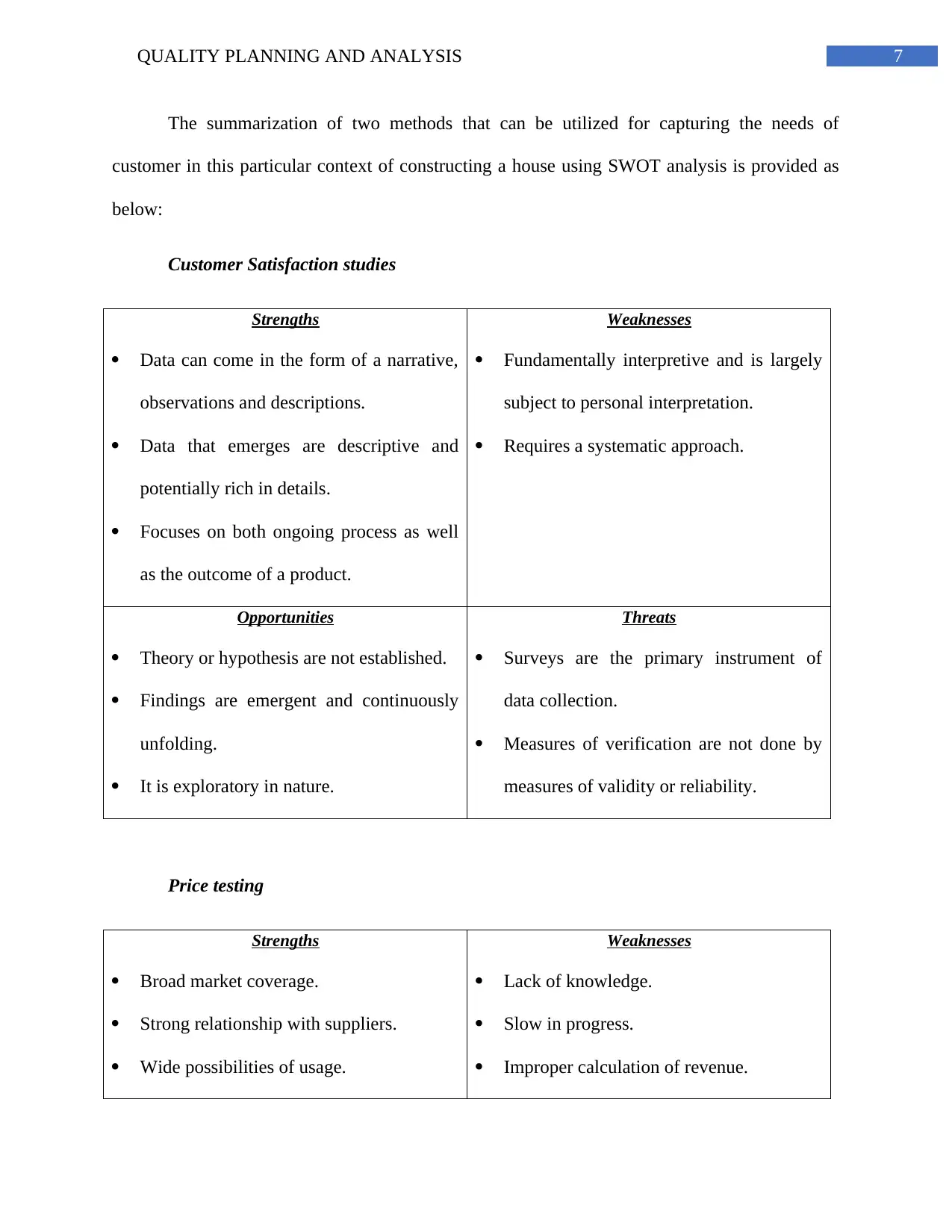
7QUALITY PLANNING AND ANALYSIS
The summarization of two methods that can be utilized for capturing the needs of
customer in this particular context of constructing a house using SWOT analysis is provided as
below:
Customer Satisfaction studies
Strengths
Data can come in the form of a narrative,
observations and descriptions.
Data that emerges are descriptive and
potentially rich in details.
Focuses on both ongoing process as well
as the outcome of a product.
Weaknesses
Fundamentally interpretive and is largely
subject to personal interpretation.
Requires a systematic approach.
Opportunities
Theory or hypothesis are not established.
Findings are emergent and continuously
unfolding.
It is exploratory in nature.
Threats
Surveys are the primary instrument of
data collection.
Measures of verification are not done by
measures of validity or reliability.
Price testing
Strengths
Broad market coverage.
Strong relationship with suppliers.
Wide possibilities of usage.
Weaknesses
Lack of knowledge.
Slow in progress.
Improper calculation of revenue.
The summarization of two methods that can be utilized for capturing the needs of
customer in this particular context of constructing a house using SWOT analysis is provided as
below:
Customer Satisfaction studies
Strengths
Data can come in the form of a narrative,
observations and descriptions.
Data that emerges are descriptive and
potentially rich in details.
Focuses on both ongoing process as well
as the outcome of a product.
Weaknesses
Fundamentally interpretive and is largely
subject to personal interpretation.
Requires a systematic approach.
Opportunities
Theory or hypothesis are not established.
Findings are emergent and continuously
unfolding.
It is exploratory in nature.
Threats
Surveys are the primary instrument of
data collection.
Measures of verification are not done by
measures of validity or reliability.
Price testing
Strengths
Broad market coverage.
Strong relationship with suppliers.
Wide possibilities of usage.
Weaknesses
Lack of knowledge.
Slow in progress.
Improper calculation of revenue.
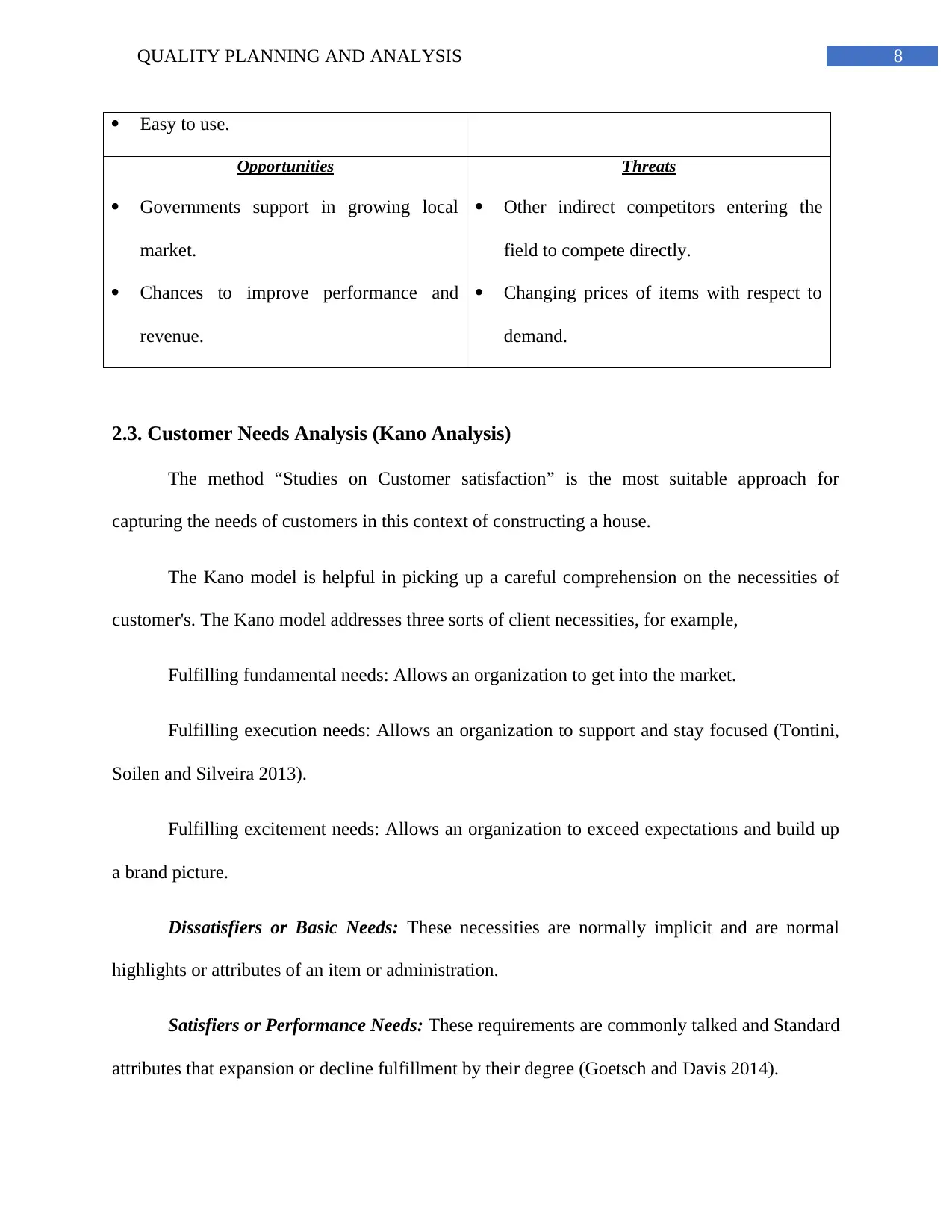
8QUALITY PLANNING AND ANALYSIS
Easy to use.
Opportunities
Governments support in growing local
market.
Chances to improve performance and
revenue.
Threats
Other indirect competitors entering the
field to compete directly.
Changing prices of items with respect to
demand.
2.3. Customer Needs Analysis (Kano Analysis)
The method “Studies on Customer satisfaction” is the most suitable approach for
capturing the needs of customers in this context of constructing a house.
The Kano model is helpful in picking up a careful comprehension on the necessities of
customer's. The Kano model addresses three sorts of client necessities, for example,
Fulfilling fundamental needs: Allows an organization to get into the market.
Fulfilling execution needs: Allows an organization to support and stay focused (Tontini,
Soilen and Silveira 2013).
Fulfilling excitement needs: Allows an organization to exceed expectations and build up
a brand picture.
Dissatisfiers or Basic Needs: These necessities are normally implicit and are normal
highlights or attributes of an item or administration.
Satisfiers or Performance Needs: These requirements are commonly talked and Standard
attributes that expansion or decline fulfillment by their degree (Goetsch and Davis 2014).
Easy to use.
Opportunities
Governments support in growing local
market.
Chances to improve performance and
revenue.
Threats
Other indirect competitors entering the
field to compete directly.
Changing prices of items with respect to
demand.
2.3. Customer Needs Analysis (Kano Analysis)
The method “Studies on Customer satisfaction” is the most suitable approach for
capturing the needs of customers in this context of constructing a house.
The Kano model is helpful in picking up a careful comprehension on the necessities of
customer's. The Kano model addresses three sorts of client necessities, for example,
Fulfilling fundamental needs: Allows an organization to get into the market.
Fulfilling execution needs: Allows an organization to support and stay focused (Tontini,
Soilen and Silveira 2013).
Fulfilling excitement needs: Allows an organization to exceed expectations and build up
a brand picture.
Dissatisfiers or Basic Needs: These necessities are normally implicit and are normal
highlights or attributes of an item or administration.
Satisfiers or Performance Needs: These requirements are commonly talked and Standard
attributes that expansion or decline fulfillment by their degree (Goetsch and Davis 2014).
⊘ This is a preview!⊘
Do you want full access?
Subscribe today to unlock all pages.

Trusted by 1+ million students worldwide
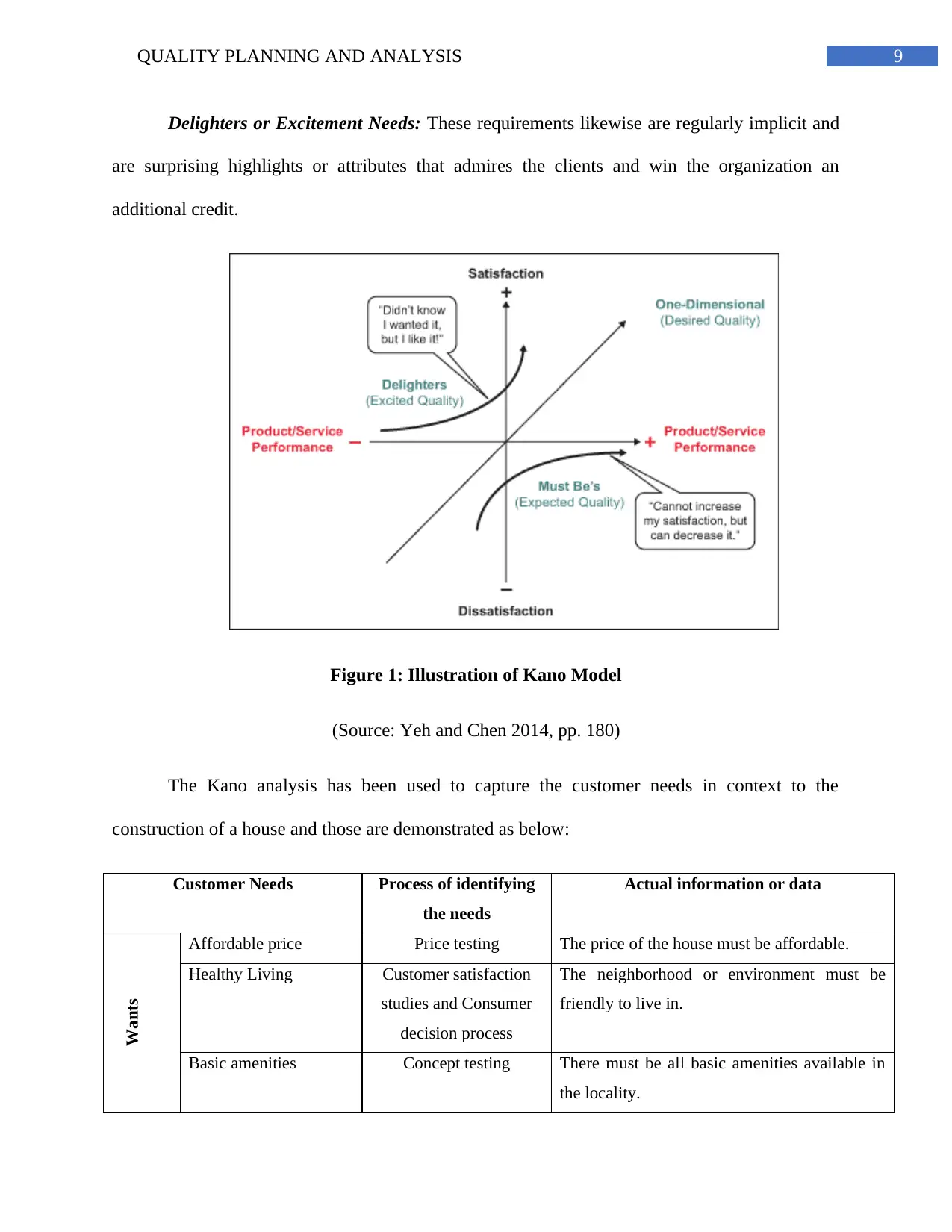
9QUALITY PLANNING AND ANALYSIS
Delighters or Excitement Needs: These requirements likewise are regularly implicit and
are surprising highlights or attributes that admires the clients and win the organization an
additional credit.
Figure 1: Illustration of Kano Model
(Source: Yeh and Chen 2014, pp. 180)
The Kano analysis has been used to capture the customer needs in context to the
construction of a house and those are demonstrated as below:
Customer Needs Process of identifying
the needs
Actual information or data
Wants
Affordable price Price testing The price of the house must be affordable.
Healthy Living Customer satisfaction
studies and Consumer
decision process
The neighborhood or environment must be
friendly to live in.
Basic amenities Concept testing There must be all basic amenities available in
the locality.
Delighters or Excitement Needs: These requirements likewise are regularly implicit and
are surprising highlights or attributes that admires the clients and win the organization an
additional credit.
Figure 1: Illustration of Kano Model
(Source: Yeh and Chen 2014, pp. 180)
The Kano analysis has been used to capture the customer needs in context to the
construction of a house and those are demonstrated as below:
Customer Needs Process of identifying
the needs
Actual information or data
Wants
Affordable price Price testing The price of the house must be affordable.
Healthy Living Customer satisfaction
studies and Consumer
decision process
The neighborhood or environment must be
friendly to live in.
Basic amenities Concept testing There must be all basic amenities available in
the locality.
Paraphrase This Document
Need a fresh take? Get an instant paraphrase of this document with our AI Paraphraser
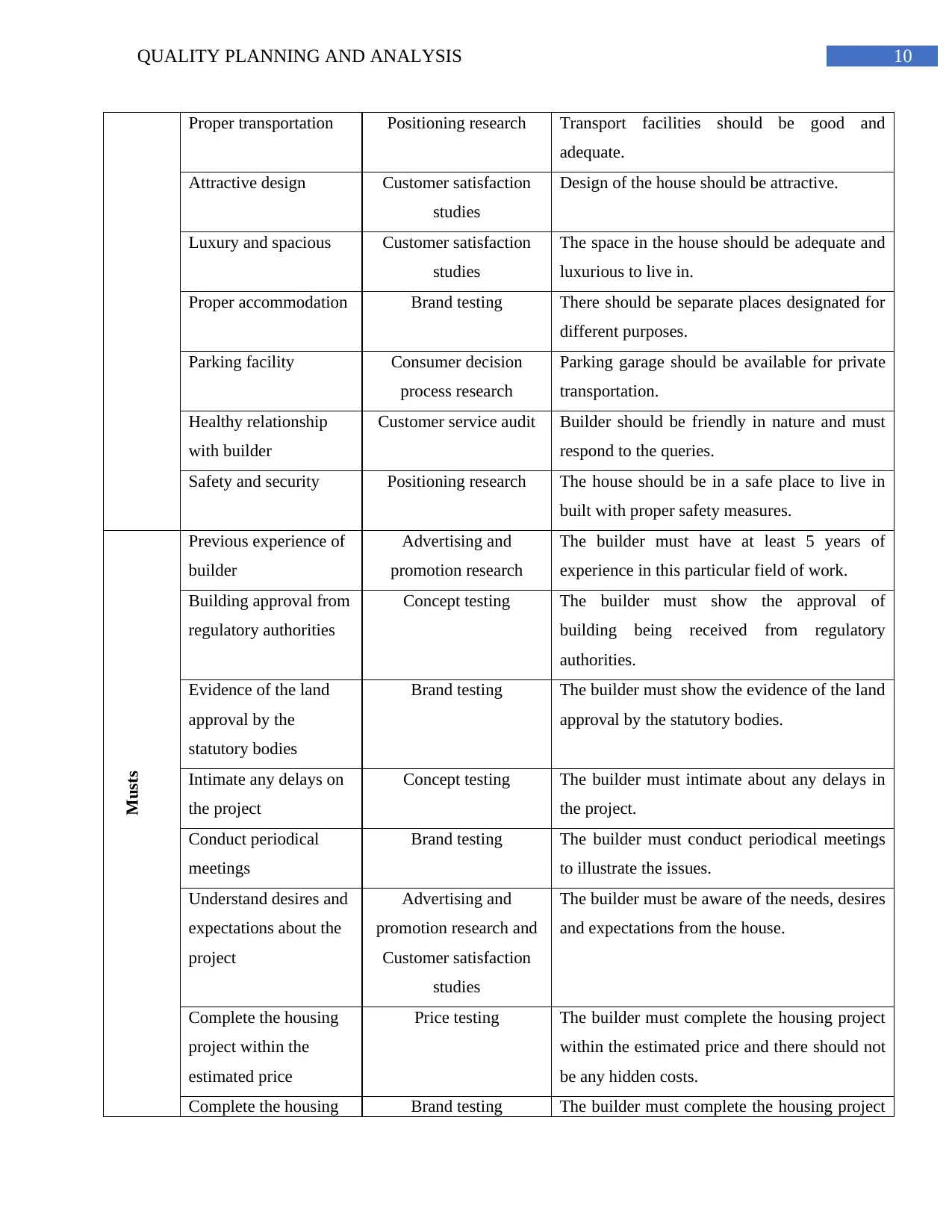
10QUALITY PLANNING AND ANALYSIS
Proper transportation Positioning research Transport facilities should be good and
adequate.
Attractive design Customer satisfaction
studies
Design of the house should be attractive.
Luxury and spacious Customer satisfaction
studies
The space in the house should be adequate and
luxurious to live in.
Proper accommodation Brand testing There should be separate places designated for
different purposes.
Parking facility Consumer decision
process research
Parking garage should be available for private
transportation.
Healthy relationship
with builder
Customer service audit Builder should be friendly in nature and must
respond to the queries.
Safety and security Positioning research The house should be in a safe place to live in
built with proper safety measures.
Musts
Previous experience of
builder
Advertising and
promotion research
The builder must have at least 5 years of
experience in this particular field of work.
Building approval from
regulatory authorities
Concept testing The builder must show the approval of
building being received from regulatory
authorities.
Evidence of the land
approval by the
statutory bodies
Brand testing The builder must show the evidence of the land
approval by the statutory bodies.
Intimate any delays on
the project
Concept testing The builder must intimate about any delays in
the project.
Conduct periodical
meetings
Brand testing The builder must conduct periodical meetings
to illustrate the issues.
Understand desires and
expectations about the
project
Advertising and
promotion research and
Customer satisfaction
studies
The builder must be aware of the needs, desires
and expectations from the house.
Complete the housing
project within the
estimated price
Price testing The builder must complete the housing project
within the estimated price and there should not
be any hidden costs.
Complete the housing Brand testing The builder must complete the housing project
Proper transportation Positioning research Transport facilities should be good and
adequate.
Attractive design Customer satisfaction
studies
Design of the house should be attractive.
Luxury and spacious Customer satisfaction
studies
The space in the house should be adequate and
luxurious to live in.
Proper accommodation Brand testing There should be separate places designated for
different purposes.
Parking facility Consumer decision
process research
Parking garage should be available for private
transportation.
Healthy relationship
with builder
Customer service audit Builder should be friendly in nature and must
respond to the queries.
Safety and security Positioning research The house should be in a safe place to live in
built with proper safety measures.
Musts
Previous experience of
builder
Advertising and
promotion research
The builder must have at least 5 years of
experience in this particular field of work.
Building approval from
regulatory authorities
Concept testing The builder must show the approval of
building being received from regulatory
authorities.
Evidence of the land
approval by the
statutory bodies
Brand testing The builder must show the evidence of the land
approval by the statutory bodies.
Intimate any delays on
the project
Concept testing The builder must intimate about any delays in
the project.
Conduct periodical
meetings
Brand testing The builder must conduct periodical meetings
to illustrate the issues.
Understand desires and
expectations about the
project
Advertising and
promotion research and
Customer satisfaction
studies
The builder must be aware of the needs, desires
and expectations from the house.
Complete the housing
project within the
estimated price
Price testing The builder must complete the housing project
within the estimated price and there should not
be any hidden costs.
Complete the housing Brand testing The builder must complete the housing project
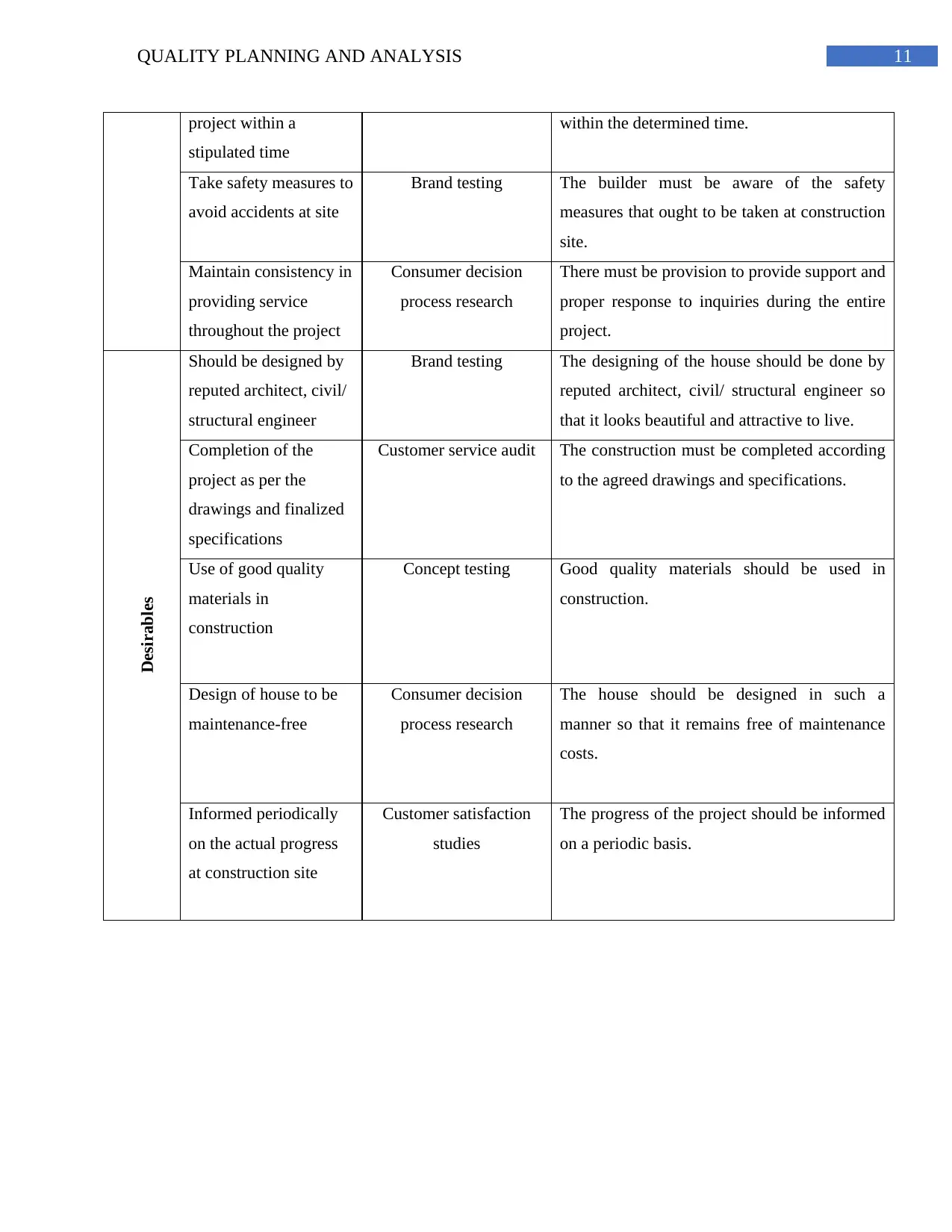
11QUALITY PLANNING AND ANALYSIS
project within a
stipulated time
within the determined time.
Take safety measures to
avoid accidents at site
Brand testing The builder must be aware of the safety
measures that ought to be taken at construction
site.
Maintain consistency in
providing service
throughout the project
Consumer decision
process research
There must be provision to provide support and
proper response to inquiries during the entire
project.
Desirables
Should be designed by
reputed architect, civil/
structural engineer
Brand testing The designing of the house should be done by
reputed architect, civil/ structural engineer so
that it looks beautiful and attractive to live.
Completion of the
project as per the
drawings and finalized
specifications
Customer service audit The construction must be completed according
to the agreed drawings and specifications.
Use of good quality
materials in
construction
Concept testing Good quality materials should be used in
construction.
Design of house to be
maintenance-free
Consumer decision
process research
The house should be designed in such a
manner so that it remains free of maintenance
costs.
Informed periodically
on the actual progress
at construction site
Customer satisfaction
studies
The progress of the project should be informed
on a periodic basis.
project within a
stipulated time
within the determined time.
Take safety measures to
avoid accidents at site
Brand testing The builder must be aware of the safety
measures that ought to be taken at construction
site.
Maintain consistency in
providing service
throughout the project
Consumer decision
process research
There must be provision to provide support and
proper response to inquiries during the entire
project.
Desirables
Should be designed by
reputed architect, civil/
structural engineer
Brand testing The designing of the house should be done by
reputed architect, civil/ structural engineer so
that it looks beautiful and attractive to live.
Completion of the
project as per the
drawings and finalized
specifications
Customer service audit The construction must be completed according
to the agreed drawings and specifications.
Use of good quality
materials in
construction
Concept testing Good quality materials should be used in
construction.
Design of house to be
maintenance-free
Consumer decision
process research
The house should be designed in such a
manner so that it remains free of maintenance
costs.
Informed periodically
on the actual progress
at construction site
Customer satisfaction
studies
The progress of the project should be informed
on a periodic basis.
⊘ This is a preview!⊘
Do you want full access?
Subscribe today to unlock all pages.

Trusted by 1+ million students worldwide
1 out of 38
Related Documents
Your All-in-One AI-Powered Toolkit for Academic Success.
+13062052269
info@desklib.com
Available 24*7 on WhatsApp / Email
![[object Object]](/_next/static/media/star-bottom.7253800d.svg)
Unlock your academic potential
Copyright © 2020–2025 A2Z Services. All Rights Reserved. Developed and managed by ZUCOL.





